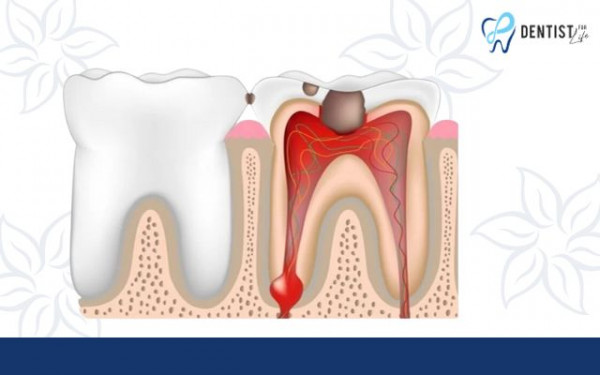Together with tooth decay and gum inflammation, dental pulpitis is one of the most common dental diseases today. Pulpitis not only causes patients to feel pain and discomfort but can also lead to many dangerous complications if not examined and treated promptly. Let’s learn more about pulpitis, its causes, and treatment methods at Dentist For Life Dental Clinic in the following article.
What is pulpitis?
The dental pulp is a specialized connective tissue containing numerous nerve fibers and blood vessels located within a cavity in the center of the tooth. The dental pulp is present in both the crown and root of the tooth (referred to as the pulp chamber and root canal), surrounded by the tooth enamel and dentin. The root canal in the tooth’s root consists of very small and delicate tissue fibers, branching from the pulp chamber in the crown of the tooth down to the tip of the root.
What are the types of pulpitis?

Pulpitis is classified into two types by dentists, depending on the severity of the infection.
One type is reversible pulpitis, which can be treated by a dentist with tooth repair and sealing with a filling in the early stage.
The other type is irreversible pulpitis, where the inflammation is more advanced and the tooth cannot recover. This can lead to pulp tissue death, known as pulp necrosis.
See more: What is periodontics? What is periodontitis? Cause and signs of identification
What are the symptoms of pulpitis?
The symptoms of pulpitis primarily involve toothache and sensitivity, their intensity varying with the inflammation’s stage. Reversible pulpitis is characterized by the absence of pain when the tooth is tapped by the dentist, along with no sensitivity to heat but sensitivity to cold or sweets that swiftly dissipate, often described as sharp pain.
Conversely, irreversible pulpitis exhibits pain upon dental tapping and lingering sensitivity to heat, cold, or sweets, persisting for more than a few seconds and described as throbbing, aching, or sharp. In cases of pulp necrosis where nerve tissue dies, there might be an absence of sensitivity to heat, cold, or sweets, yet the tooth may still elicit pain when tapped by the dentist.
What causes pulpitis?
The cause of pulpitis is often related to damage to the hard enamel of the tooth, which normally protects the pulp. This damage can be a result of various factors, including:
- Cavities: Bacteria in the mouth can produce acid that erodes the enamel, leading to the formation of holes.
- Cracks: Chewing on hard foods or experiencing a tooth injury can result in small cracks in the enamel.
- Dental procedures: Even dental treatments alone can cause pulpitis, especially if a tooth is not properly sealed during the procedure, leading to leakage and subsequent inflammation.
- Worn enamel: Grinding teeth or aggressive brushing can wear down the enamel, making the nerve more susceptible to inflammation.
How is pulpitis treated?
The treatment for pulpitis depends on the extent of the inflammation. Reversible pulpitis can often be resolved by removing the cause, such as decay, and sealing the tooth with a filling. However, irreversible pulpitis requires more intensive treatment to remove the infected pulp tissue.
Treatment options for irreversible pulpitis include a root canal, where a specialist removes the infected pulp and fills the empty root canal before sealing the tooth. Alternatively, some people may opt for a tooth extraction, and the dentist will discuss options for replacing the tooth, such as dental implants or bridges.
While antibiotics are not a direct treatment for pulpitis, they may be prescribed to prevent the problem from progressing into an infection if there is a delay in treatment.
See more: Quick and Easy Methods for Tightening a Loose Tooth at Home
What are the possible complications of pulpitis?

When left unaddressed, pulpitis can result in several complications. If the condition progresses, it may lead to infection or the formation of an abscess, manifesting as pain, fever, and swelling of neck glands.
Moreover, an untreated infection can potentially spread to surrounding areas such as the jawbone (causing osteomyelitis) and the soft tissues across the head, neck, and chest. Failure to treat these infections promptly can pose life-threatening risks.
Prevention
Preventing pulpitis primarily relies on maintaining excellent oral hygiene practices. This includes brushing your teeth twice daily, consistent daily flossing, and regular dental checkups and cleanings. For those who grind their teeth at night, using a night guard can be beneficial. Additionally, prompt communication with your dentist is crucial if you experience any tooth pain or sensitivity, allowing for timely assessment and necessary intervention.
See more: Understanding Gum Recession: Causes, Symptoms, and Treatment
Conclusion
At Dentist For Life, we understand the significance of addressing dental pulpitis promptly and effectively. Our commitment to comprehensive dental care extends to identifying and managing conditions like pulpitis with precision and care.
We prioritize patients’ comfort and oral health, offering personalized treatments tailored to alleviate discomfort and preserve dental wellness. Trust us for exceptional care and guidance, ensuring your journey to a pain-free, healthy smile. Schedule a consultation today and experience our dedication to resolving dental concerns with expertise and compassion.



